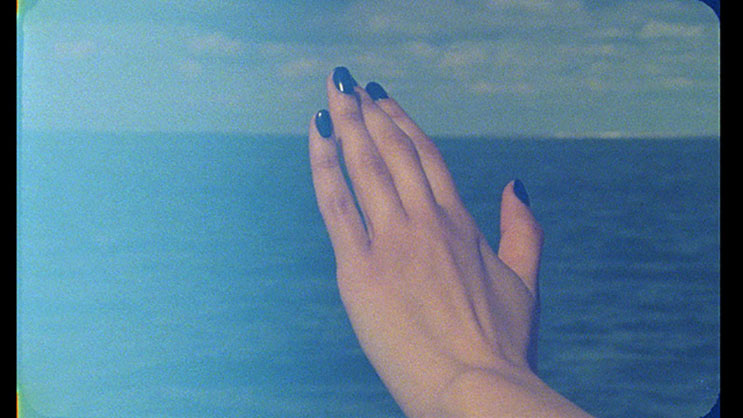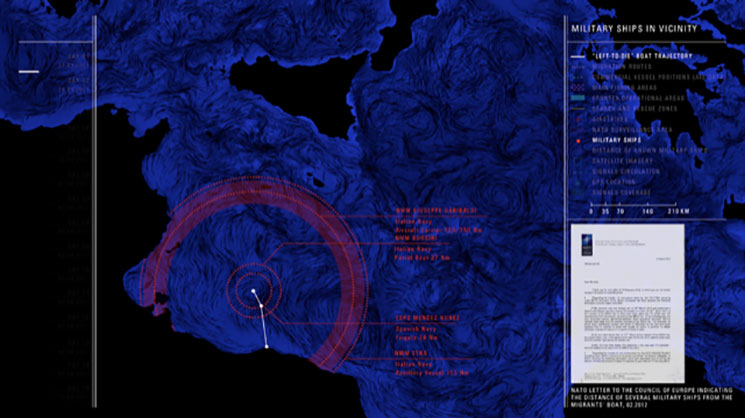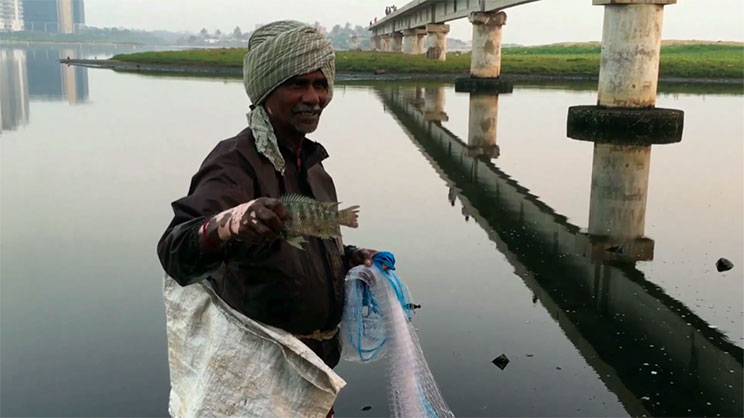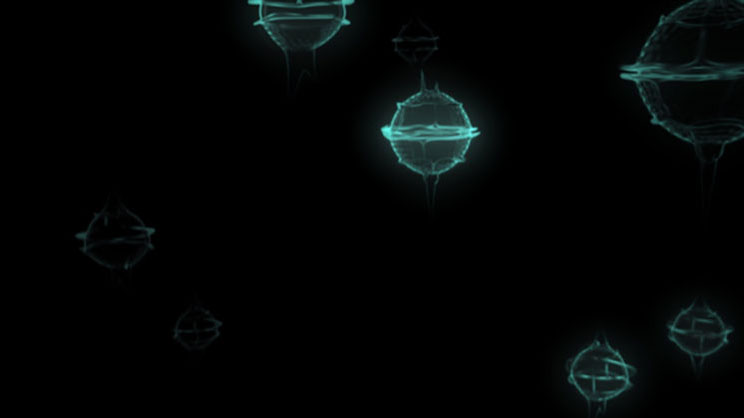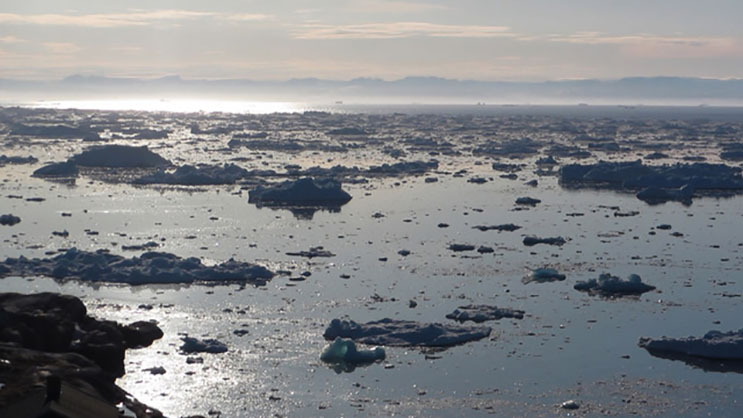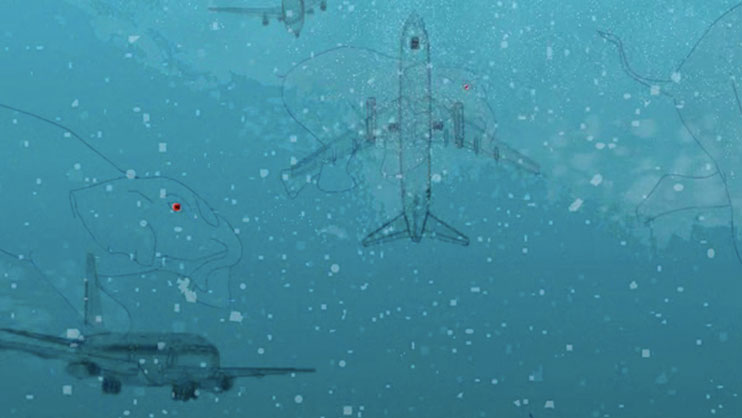Images credits: Ana Vaz, Occidente, Film Still, 2015; Forensic Oceanography, Liquid Traces – The Left-to-die Boat Case (2014, 17 min), Film Still; Michelle-Marie Letelier, Outline for the Bonding, Film Still, from 16mm film transferred to digital, 2017; Parvati Nayar, By the Mouth of the River, Film Still, 2018; Susanne M. Winterling, EXCERPT FROM GLISTENING TROUBLES (STILL), 2017, 1 MIN., 4K CGI VIDEO; Tue Greenfort, Horsehoe Crabs, Companion Species, Youtube Series I, 2013/2017, 12:30 min, Film Still; Ursula Biemann, Subatlantic, Film Still, 2015; Marina Zurkow, Weights and Measures, Film Still, 2007.
“WE ARE OCEAN, curated film program”
WE ARE OCEAN – curated film program (total length 1 h 4 min)
Text by Julia Moritz
This program of short artist films gathers eight international positions which are dedicated in various ways to the complex relationship between humans and oceans. The programme unfolds a spectrum that begins with the tourist versus scientific view on marine life and its peculiar aesthetical and biological features; it includes historical and current conflict over natural resources as well as cultural difference; and it does not end with ethical and emotional questions regarding our responsibilities for the seas.
The films have been selected by Anne-Marie Melster (Executive Director and Co-Founder of ARTPORT) and Julia Moritz (independent curator and educator) for the project WE ARE OCEAN: an interdisciplinary art project by the non-profit organisation ARTPORT_making waves, that seeks to bring artists, students, scientists, politicians, art collectors, teachers and curators in conversation about the precarious environmental conditions of the oceans.
Artists: Ursula Biemann (Switzerland), Forensic Oceanography (United Kingdom), Tue Greenfort (Denmark), Michelle-Marie Letelier (Chile/Germany), Parvathi Nayar (India), Ana Vaz (Brasil), Susanne M. Winterling (Germany), Marina Zurkow (USA)
TUE GREENFORT, HORSESHOE CRABS, COMPANION SPECIES, YOUTUBE SERIES I, 2013/17, 12:30 MIN.
The video work Horseshoe Crabs, Companion Species, YouTube Series I visualizes the paradoxes of the nature-culture-divide on a media-reflective level: Harvested entirely from YouTube, holiday home videos from the beach – in which the alien-like bodies of horseshoe crabs are met with exquisite fear and exploratory bravery by pals and pets alike – are interlaced with scientific documentation of the creatures’ bio-chemical features and methods of study. Atmospheric electronic music and a creepy computerized voice-over add to the technological dimension of the bio-political configurations, in this case studies of a “companion species” (Donna Haraway) and an example of “multi-species-intra-action” (Karan Barad). A body politic torn open, simultaneously exterminated and recreated, from egg-state to industrial and scientific afterlife – a fossil life-form haunting our seas and shores.
Tue Greenfort’s interdisciplinary practice deals with issues such as the public and private realm, nature and culture. Interweaving these subjects with the language of art he formulates a multi-facetted critique of today’s dominant economical and scientific production. Intrigued by the dynamics in the natural world, Greenfort’s work often evolves around ecology and its history, including the environment, social relations, and human subjectivity.
Tue Greenfort (*1973 in Holbaek/Denmark) lives and works in Berlin where he is represented by KÖNIG GALERIE. His work was on view recently in a solo exhibition at DEN FRIE, and at Roskilde Festival, Copenhagen, as well as in a a group show at Arken Museum of Modern Art, Ishøj, at the Aarhus Triennale, Aarhus and at TBA21, Vienna. As a participant of dOCUMENTA(13) in Kassel, Greenfort co-curated an archive on multi-species and co-evolution, named The Worldly House. He has had extensive solo presentations at The Museum of Contemporary Art Oslo, Oslo (2016); Sorø Kunstmuseum (2014;, SculptureCenter, New York (2013); Berlinische Galerie (2012); South London Gallery (2011); Kunstverein Braunschweig (2008) and Secession, Vienna (2007). Among his publications the most comprehensive, Linear Deflection (2009), was published by Walther König.
ANA VAZ, OCCIDENTE, 2015, 15 MIN.
Occidente may be described as a film-poem of an ecology of signs that speaks of colonial history repeating itself: subalterns become masters, antiques become reproducible dinner sets, exotic birds become luxury currency, exploration becomes extreme-sport-tourism, monuments become geodata. “A voyage eastwards and westwards marking cycles of expansion in a struggle to find one’s place, one’s sitting around a table. The ocean before the continent, the Atlantic before the Occidente. Infinite, vibrant variations of blue, howling, cries of anger, the growl of a world whose history starts in pain and metamorphosis. The Middle Passage comes first here – it all begins where it all usually ends. Yesterday’s impeccably bright lights are turning to petrol blue. Rejoice! The old narrator has drowned, and along with him were lost all the languages that once served to make the finest maps and books drawn on to talk, in all occasions, wherever we were, of any one thing. Locked in their apartments, the masters enjoy a banquet as the decor’s cracks deepen and their most faithful servants have already followed the aquatic world’s call. Rejoice! All is overturned. In the storm, the survivors stand in silence, humble creatures amongst many others, listening to the story of the magnetic fields, of the possessions’ power – the tale of a world told in the language of the objects and the preys.” (Ana Vaz)
Ana Vaz is an artist and filmmaker whose works speculate upon the relationships between oneself and others, myths and histoires, through a cosmology of signs, references and perspectives. Her films combine elements of ethnography and speculation in order to explore the frictions and fictions that reside amongst the more cultured as well as the wilder environments and their various inhabitants.
Ana Vaz (*1986, Brasília) is a graduate of the Royal Melbourne Institute of Technology and Le Fresnoy. She was also a member of SPEAP (School of Political Arts), a project by Bruno Latour. Her recent film screenings include NYFF, TIFF, Courtisane, Cinéma du Réel (Grand Prix) and special presentations of her work at Flaherty Seminar (USA) and Doc’s Kingdom (Portugal). Her work was also presented in larger group exhibitions such as Moscow Biennial for Young Art and the Dhaka Art Summit. In 2015 Vaz received the Kazuko Trust Award of the Film Society of Lincoln Center.
MARINA ZURKOW, WEIGHTS AND MEASURES, 2007, 3:00 MIN.
Airplanes, elephants, and plankton – three beautiful “machines.” Weights and Measures compares proverbial apples and oranges, in order to probe a system of relative values. Take any two of the three creatures in the system: in water, airplanes sink while elephants swim. Elephants and airplanes both release methane, and both have been instruments of transport and war. Airplanes produce carbon dioxide, while plankton consumes it. As the largest land mammal, elephants are at the top of the terrestrial food chain, and microscopic plankton are at the bottom; yet, without phytoplankton, the oceans would starve. Each “machine” brings into focus several facets of a complex ecosystem, which includes the economics of short-term imperatives and long-view evolutionary time; the microscopic and the monumental; and human interventions of biological technology.
Marina Zurkow is a media artist focused on near-impossible nature and culture intersections, researching “wicked problems” like invasive species, superfund sites, and petroleum interdependence. She has used life science, bio materials, animation, dinners and software technologies to foster intimate connections between people and non-human agents. Her work spans gallery installations and unconventional public participatory projects. Currently, she is working on connecting toxic urban waterways to oceans, and researching the tensions between maritime ecology and the ocean’s primary human use as a capitalist Pangea.
Marina Zurkow’s (*1962) recent solo shows include Chronus Art Center, Shanghai; bitforms gallery, New York; Montclair Museum of Art, and Diverseworks, Houston, and exhibitions at Sundance New Frontiers; FACT, Liverpool; SF MoMA; Walker Art Center; Smithsonian American Art Museum; Museum of Fine Arts, Houston; Wave Hill, NY, and the National Museum for Women in the Arts. Zurkow has collaborated with Social Science and Humanities scholars at Rice University, New York University, and the University of Minnesota. She is a 2011 Guggenheim Fellow, and received grants from NYFA, NYSCA, the Rockefeller Foundation, and Creative Capital. She is a full time faculty member at ITP / Tisch School of the Arts, New York University, and is represented by bitforms gallery.
PARVATHI NAYAR, BY THE MOUTH OF THE RIVER, 2018, 13:17 MIN
By The Mouth of the River brings together a time by the mouth of the river, organically linked to its various stories. The Adyar River in Chennai, about 42.5 kilometres long, is unfortunately a dumping ground for some of the city’s sewage, as is evident near the mouth of the river. The River is traversed at this point by Broken Bridge – a shattered bridge that leads nowhere and feels like a metaphor for the state of the river. It is a spot of great emotive beauty, a potentially dangerous place after hours and a site where garbage collects. By The Mouth of the River draws from the grim realities of the site, the more whimsical narratives of the object, as well as the interventions of man, time and nature. The film was first presented as part of an installation titled Invite/Refuse along with a large-scale ground drawing created out of garbage and other artefacts; as one of the artworks of the Indo-German public art project initiated by the Goethe Institut Chennai called the Damned Art Project. Parvathi’s process involved the creation of a community project, involving volunteers called to action by the environmental activists of the Vettiver Collective, the Citizen consumer and civic Action Group and the filmmaker herself. Along with over thirty volunteers at varying times, numerous expeditions to the site were undertaken to collect the garbage thrown up by the river. The volunteers, from all walks of life, were generous with their time. Chatter while collecting the garbage centred on the upcoming turtle hatching season on these very sands; reports that say how in India some 100.000 metric tonnes of solid waste are created every day; the irony of waste-picking being treated as one of the lowliest occupations in urban India. The process was exhaustively filmed along with the site and its stories – the fishermen still looking for sustenance in these polluted areas, the birds, the garbage and the small object poem of the returning piece of garbage.
Parvathi Nayar regularly uses science as a visual language to explore the world through unusual microscopic and macroscopic perspectives. She is co-founder of the art collective The Hashtag#Collective. Parvathi mixes together old and new media as in the hand-drawn graphite work The Seeds of Things paired with its companion video The Nature of Things, created for the show To Let The World In curated by Dr Chaitanya Sambrani, Art Chennai, Lalit Kala Akademi (2012). Parvathi was invited to the Kochi-Muziris Biennale 2014/15 for which she created an installation of drawings and sound titled The Fluidity of Horizons. Her large-scale permanent installations include the 20-foot-high drawn sculpture artwork at the new Mumbai airport (2014) and 30-foot-long silkscreened mural The Music of the Spheres at the Chennai Mathematical Institute.
Parvathi Nayar (*1964, Delhi) is a visual artist and creative writer. She is best known for her videos, drawings, mixed media installations and photography. Parvathi’s work examines the narratives of spatial relationships, both the internal/intimate and the external/public, and often through the prism of science and technology. Her works have been exhibited in India, Singapore, UK, Dubai, France and Indonesia. Her works of video art have been shown at venues such as the 12th International Documentary and Short Film Festival of Kerala (2019) and 20th Madurai International Documentary and Short Film Festival (2018). Parvathi is a two-time TedX speaker, including “TEDx Chennai” held in October 2016 at Chennai. She received her MA in Fine Art at Central Saint Martins College of Art and Design, London (2004); and her BA in Fine Art at Stella Maris College, University of Madras (1985).
FORENSIC OCEANOGRAPHY, LIQUID TRACES (EXCERPT), 2014, 2:15 MIN.
The video Liquid Traces offers a synthesis of the “Left-to-die boat” case. In March 2011, 72 passengers left the Libyan coast heading in the direction of Italy on board a small rubber boat at the time of NATO’s military intervention in Libya. Despite several distress signals relaying their location, as well as repeated interactions with at least one military helicopter and a military ship, they were left to drift for 14 days. As a result of the inaction of all state actors involved, only nine of the passengers survived. By combining their testimonies with wind and sea-current data as well as satellite imagery, Forensic Oceanography reconstructed the liquid traces of this event, producing a report that served as the basis of several legal complaints.
Project team: Charles Heller, Lorenzo Pezzani, Richard Limeburner, Samaneh Moafi, Rossana Padeletti
Produced within the frame of Forensic Architecture with the support of the House of World Cultures (HKW), Berlin.
Working together since 2011, Charles Heller and Lorenzo Pezzani co-founded the Forensic Oceanography project, that critically investigates the militarized border regime and the politics of migration in the Mediterranean Sea. Their collaborative work has generated human rights reports, academic articles as well as videos that have been exhibited internationally.
Charles Heller (*1981, Switzerland) is a researcher and filmmaker whose work has a long-standing focus on the politics of migration. In 2015, he completed a Ph.D. in Research Architecture at Goldsmiths, University of London. He is currently a postdoctoral fellow at the Graduate Institute, in Geneva, where is conducts research supported by the Swiss National Fund.
Lorenzo Pezzani (*1982, Italy) is an architect and researcher. In 2015, he completed a Ph.D. in Research Architecture at Goldsmiths, University of London, where he is currently Lecturer and leads the MA studio in Forensic Architecture. His work deals with the spatial politics and visual cultures of migration, with a particular focus on the geography of the ocean.
MICHELLE-MARIE LETELIER, OUTLINE FOR THE BONDING, 2016–ONGOING, 5:25 MIN.
The project “Outline for the Bonding” is a 16mm-film-observation for her ongoing project documenting the interaction of the artist with a farmed salmon during its 2,5 years of life and their bonding during that time. The film is the focus of an ongoing project called Transpose, a research venture in which the relationship between the Northern and Southern Hemispheres in relation to salmon aquaculture is examined. In the first research phase in Bergen and Lofoten, Letelier worked with fishermen and scientists from the University of Bergen. The aim of the research was to investigate the history of salmon aquaculture in terms of fishing techniques and current technologies, as well as to understand ethical and political contexts. Together with the University’s paleontological department, otoliths, which serve as a kind of chemical diary of fish, were preserved. Then Letelier experimented with the 16mm-film and examined the properties of the film material – which also undergoes a photochemical process – on its chemical reaction. As a result of this observation, both the artistic interest in making a personal connection to a farmed salmon and in documenting the effects of this relationship on film arose.
The project aims to unpack the techno-antiseptic Cartesian environment that is constructed for the salmon by translating it to the grainy and imperfect 16mm-film-aesthetics. A preliminary result is the experience of a sensory interaction between two species.
Michelle-Marie Letelier’s installations, photographs, videos and drawings encompass orchestrated transformations of natural resources, alongside extensive wide-ranging, interdisciplinary research into the landscapes where their exploitation and speculation take place. Her work juxtaposes different epochs, regions and societies, examining political-economic, historical and cultural aspects. Michelle-Marie Letelier spent her early life in Chuquicamata, a space of copper deposits in the middle of the Atacama Desert of mined since pre-Hispanic times, annexed by Chile in the Saltpetre War (1879-84), and home to the largest copper mine in the world. Since establishing in Berlin in 2007, she has focused her research on five resources: coal, copper, saltpetre, wind and, more recently, Atlantic salmon, in order to create a poetic work applying their properties – such as electrical conductivity, crystallisation and liveliness. The work of Michelle-Marie Letelier carries heavy socio-political overtones and is reflective especially in times of unveiled globalization, the increasing scarcity of raw materials and the crisis of the neoliberal model.
Michelle-Marie Letelier (*1977, Rancagua/Chile) currently lives and works in Berlin. She obtained her Bachelor of Arts from the Universidad Católica de Chile in 2000 and has participated in postgraduate programmes such as Goldrausch Künstlerinnenprojekt art IT in Berlin and as guest student in the Experimental Media Design studies at the Universität der Künste, Berlin. Her work has been shown internationally in galleries, museums and institutions, among others: CNB Contemporánea, Buenos Aires; Monumento a Los Héroes, Bogotá; El Museo de Los Sures, New York; Stiftelsen 3,14, Bergen; Museo de la Solidaridad Salvador Allende, Santiago; Fondazione Cini, Venice; and Errant Bodies, Berlin. Her videos have been exhibited in international screenings and festivals, including the Mercosur Biennial, Porto Alegre; East Asia Contemporary Art Space, Shanghai, and X Video and Media Arts Biennial, Santiago. Letelier was awarded the first edition of ORA Prize (2011). She has been a resident at ISCP, New York (2014); USF, Bergen (2017), Kunstnerhuset, Svolvær (2018), Magallanes2020, Punta Arenas (2018); ISLA, Antofagasta (2018), and Troms fylkeskultursenter, Tromsø (2019).
URSULA BIEMANN, SUBATLANTIC, 2015, 11 MIN.
With an understated touch of science fiction, Subatlantic juxtaposes the science of geology and climatology with human history. The video unfolds across the Subatlantic, the latest climatic phase of the Holocene that began about 2,500 years ago and has registered major civilizational changes. The voiceover alludes to a she-scientist who is making instrumental observations about a changing environment around the last glacial melts. From an increasingly submerged place of oceanic observation, her objects of examination are as much the physical world and the atmosphere that is engulfing her as the thoughts that are formed, reconfigured or released under the changing conditions. Subatlantic also refers to the submerged space of the Atlantic Ocean. Set in the Shetland Islands, Greenland’s Disco Bay, and a tiny Caribbean Island, the video implicates far apart locations that are connected through ocean streams, addressing submerged dynamics that are non-localized and invisible to our eye.
Ursula Biemann is an artist, author, and video essayist. Her artistic practice is strongly research-oriented and involves fieldwork in remote locations where she investigates climate change and the ecologies of oil, ice, and water. She works the findings into multi-layered videos by connecting the micropolitics on the ground with a theoretical macro level, proposing a reflexive exploration of planetary and videographic organization. Biemann’s pluralistic practice spans a range of media including experimental video, interview, text, photography, cartography, and materials, which converge in highly formalized spatial installations. Her work also adopts the form of publications, lectures, and curatorial as well as collaborative research projects. Her recent fieldwork has taken her to the Amazon and the Arctic region where she engages the larger temporalities of climate change with the project Forest Law, Deep Weather, Subatlantic and Acoustic Ocean, amplifying current discussions around ecology, multispecies communication, and videographic world-making.
Ursula Biemann (*1955, Zurich) received her BFA from the School of Visual Arts (1986) in New York and pursued post-graduate studies at the Whitney Independent Study Program (ISP) in New York where she lived most of the 1980s. She returned to Switzerland in 1990. Until 2014 she was a senior researcher at the Zurich University of the Arts and continues to give lectures and seminars worldwide. Biemann is appointed Doctor honoris causa in Humanities by the Swedish University Umea (2008). The artist had solo exhibitions at the Neuer Berliner Kunstverein, Bildmuseet Umeå in Sweden, Nikolaj Contemporary Art in Copenhagen, Helmhaus Zurich, Lentos Museum Linz, and at film festivals FID Marseille and TEK Rome. Her work also contributed to major exhibitions at the Arnolfini Bristol; Tapies Foundation Barcelona; Museum of Fine Arts Bern; LACE, Los Angeles, KIASMA Helsinki, San Francisco Art Institute; Jeu de Paume, Paris, Steirischer Herbst, Graz, Kunstverein Hamburg, and many others; In addition, the artist has participated in the International Art Biennials in Sao Paulo, Gwangju, Shanghai, Taiwan, Sharjah, Liverpool, Bamako, Istanbul, Montreal, Venice, Thessaloniki, and Sevilla. She has received the 2009 Prix Meret Oppenheim, the Swiss Grand Award for Art and the 2018 Prix Thun for Art and Ethics. She is on the board of the academic journal Geo-Humanities.
SUSANNE M. WINTERLING, GLISTENING TROUBLES (EXCERPT), 2017, 1:00 MIN.
Susanne M. Winterling’s installation Glistening Troubles deals with bioluminescent, touch-lit dinoflagellates as indicators of the state of health of potentially toxic coastal waters. The work resulted from Winterling’s residency at the TBA21 Alligator Head Foundation in Jamaica. In a video interview in the full version of the work, a fisherman from Rock provides insight into the medicinal properties of algae in the treatment of skin infections, a practice that has been known locally for centuries. The project puts the skin – through which we touch the world around us – and luminous displays – our intersections with digital reality – in metaphorical proximity. It deals with the interlocking of information in overlapping analog and virtual worlds as well as with the solidarity between the species, referring to our lively interdependence with other bodies.
Susanne M. Winterling works across media to explore the emotional economy, digital cultures, and social life of materials in the environment. Winterling’s practice reflects both political and aesthetic interdependencies and power structures between human/animal/matter. Shapes and materials tell of species and the elements in today’s challenging geopolitical context. Her work continues to focus on historical feminist practices and the commonplace, illuminating various types of knowledge through embodiment and cosmologies. Winterling works across media and with a constant challenge and questioning of artistic media in society and is known for her time-based installations, which deal critically with the representation of reality. Prevailing modernist concepts, power structures, and hierarchical historiography are captured and examined in their work in the form of spatial constellations. With a focus on strengthening our perceptual and critical awareness, Winterling conducts affective and material-based research that emphasizes the subjective interaction between producers, viewers, materials, and species in our ecology.
Susanne M. Winterling’s (*1970, Rehau/Germany) recent exhibitions and projects include Myths of the Marble, HOK Oslo, and ICA Philadelphia; List An Inventory of Shimmers, Contour Biennale 2017; Site visit, Kunstverein Freiburg; Space Elevator: Streetbodies and Donkeydreams, The Cologne Room, Los Angeles; Complicity, Kunstverein Amsterdam; and Tidalectics, TBA21 Vienna.

